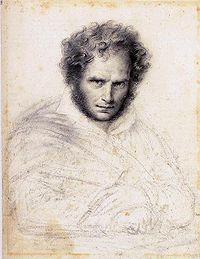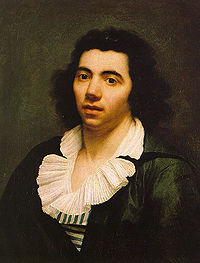
Anne-Louis Girodet de Roussy-Trioson
Encyclopedia



France
The French Republic , The French Republic , The French Republic , (commonly known as France , is a unitary semi-presidential republic in Western Europe with several overseas territories and islands located on other continents and in the Indian, Pacific, and Atlantic oceans. Metropolitan France...
painter
Painting
Painting is the practice of applying paint, pigment, color or other medium to a surface . The application of the medium is commonly applied to the base with a brush but other objects can be used. In art, the term painting describes both the act and the result of the action. However, painting is...
and pupil of Jacques-Louis David
Jacques-Louis David
Jacques-Louis David was an influential French painter in the Neoclassical style, considered to be the preeminent painter of the era...
, who was part of the beginning of the Romantic movement by adding elements of eroticism through his paintings. Girodet is remembered for his precise and clear style and for his paintings of members of the Napoleonic family.
Painting in Italy
Girodet was born at MontargisMontargis
Montargis is a commune in the Loiret department in north-central France. The town is located about south of Paris and east of Orléans in the Gâtinais....
. He lost his parents in early youth and the care of his inheritance and education fell to his guardian, M. Trioson, "medecin-de-mesdames," by whom he was in later life adopted and whose surname he took in 1812. He started in school by studying architecture and pursuing a military career. He later changed to the study of painting under a painter named Luquin, before entering the school of David
Jacques-Louis David
Jacques-Louis David was an influential French painter in the Neoclassical style, considered to be the preeminent painter of the era...
. From 1789 to 1793 he lived in Italy where, at the age of twenty-two, he successfully competed for the Prix de Rome
Prix de Rome
The Prix de Rome was a scholarship for arts students, principally of painting, sculpture, and architecture. It was created, initially for painters and sculptors, in 1663 in France during the reign of Louis XIV. It was an annual bursary for promising artists having proved their talents by...
thus making a name for himself for his painting of the Story of Joseph and his Brethren. At Rome
Rome
Rome is the capital of Italy and the country's largest and most populated city and comune, with over 2.7 million residents in . The city is located in the central-western portion of the Italian Peninsula, on the Tiber River within the Lazio region of Italy.Rome's history spans two and a half...
he painted his Hippocrate refusant les presents d'Artaxerxes and Endymion-dormant (presently held in the Louvre
Louvre
The Musée du Louvre – in English, the Louvre Museum or simply the Louvre – is one of the world's largest museums, the most visited art museum in the world and a historic monument. A central landmark of Paris, it is located on the Right Bank of the Seine in the 1st arrondissement...
), work which was praised at the Salon of 1793.
Later life
Back in France, Girodet painted many portraits, including some of the members of the Napoléon family. In 1806, he exhibited "Scène de déluge" (Louvre), to which (in competition with the "Sabines" of David) was awarded the decennial prize. This success was followed up in 1808 by the production of the "Reddition de Vienne" and "Atala au Tombeau" a work which went far to deserve its immense popularity, by a happy choice of subject, and remarkable freedom from the theatricality of Girodet's usual manner, which, however, soon returned again in his "La Révolte du Caire" (1810). Girodet was a member of the Academy of Painting and of the Institute of France; a knight of the order of St. Michael, and officer of the Legion of Honour.His powers now began to fail, and his habit of working at night and other excesses told upon his constitution; in the Salon of 1812 he exhibited only a "Tête de Vierge"; in 1819 "Pygmalion et Galatée" showed a still further decline of strength; and in 1824, the year in which he produced his portraits of Cathelineau
Jacques Cathelineau
Jacques Cathelineau , nicknamed le Saint d'Anjou , was a French Vendéan insurrection leader during the French Revolution...
and Bonchamps, Girodet died on December 9 in Paris
Paris
Paris is the capital and largest city in France, situated on the river Seine, in northern France, at the heart of the Île-de-France region...
. A sale of his effects was made after his death, and some of his drawings realized enormous prices.
Posthumously published work
Girodet produced a vast quantity of illustrations, amongst which may be cited those for the Didot VirgilVirgil
Publius Vergilius Maro, usually called Virgil or Vergil in English , was an ancient Roman poet of the Augustan period. He is known for three major works of Latin literature, the Eclogues , the Georgics, and the epic Aeneid...
(1798) and for the Louvre Racine
Jean Racine
Jean Racine , baptismal name Jean-Baptiste Racine , was a French dramatist, one of the "Big Three" of 17th-century France , and one of the most important literary figures in the Western tradition...
(1801-1805). Fifty-four of his designs for Anacreon were engraved by M. Châtillon. Girodet wasted much time on literary composition, his poem Le Peintre (a string of commonplaces), together with poor imitations of classical poets, and essays on Le Genie and La Grâce, were published after his death (1829), with a biographical notice by his friend M. Coupin de la Couperie; and M. Delecluze, in his Louis David et son temps, has also a brief life of Girodet.
Girodet: Romantic Rebel - The Art Institute of Chicago (2006), was the first retrospective in the United States devoted to the works of Anne-Louis Girodet de Roussy-Trioson. The exhibition assembled more than 100 seminal works (about 60 paintings and 40 drawings) that demonstrated the artist’s range as a painter as well as a draftsman.
View on the works
The peculiarities which mark Girodet's position as the herald of the romantic movementRomanticism
Romanticism was an artistic, literary and intellectual movement that originated in the second half of the 18th century in Europe, and gained strength in reaction to the Industrial Revolution...
are already evident in his "Endymion." He has a decided inclination to the ancient style, and the fullness of statuary is very perceptible in his works, but they are also distinguished for life, nature and beauty. His drawing is correct, and of great precision; his coloring is rich, transparent and harmonious. He works with equal care and genius. He loves to produce effect by strong lights but they are in unison with the spirit of the pieces.
The same incongruity marks Girodet's "Danae" and his "Quatre Saisons," executed for the king of Spain (repeated for Compiègne), and shows itself to a ludicrous extent in his "Fingal" St. Petersburg, Leuchtenberg collection), executed for Napoleon in 1802. This work unites the defects of the classic and romantic schools, for Girodet's imagination ardently and exclusively pursued the ideas excited by varied reading both of classic and of modern literature, and the impressions which he received from the external world afforded him little stimulus or check; he consequently retained the mannerisms of his master's practice whilst rejecting all restraint on choice of subject.
External links
- Miscellaneous works (Art Renewal CenterArt Renewal CenterThe Art Renewal Center is an organization led by New Jersey millionaire, businessman, and art collector Fred Ross dedicated to the promotion of what it terms classical realism in art, as opposed to the Modernist developments of the twentieth century...
) - Three portraits by Girodet (Insecula)

